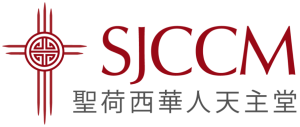天主教会的「弥撒」是什么
What is Mass?
The Celebration of Mass is in two parts that forms a single act of worship:
- The Liturgy of the Word (Word of God):
readings, homily, and general intercessions. - The Liturgy of the Eucharist (Body of the Lord):
presentation of the bread and wine, consecratory thanksgiving, and communion.
弥撒亦称「感恩祭」,是圣教会祭献天主的大礼,其名称来自拉丁文Missa的音译。古代圣教会举行感恩祭时,在礼仪结束时会向参礼会众说:「Ite, missa est」(拉丁文)意思是:「弥撒礼成,你们去传布福音吧」!因此,「弥撒」便成了感恩祭的代用名称。
弥撒来源于《圣经‧新约》的最后晚餐。根据福音书记载,耶稣在受难前夕的晚餐中,分别拿起无酵饼和葡萄酒,感谢祝福了,把饼、酒变成自己的圣体圣血,交给门徒们吃、喝,并命令门徒们要这样做,来纪念祂;晚餐后,耶稣即被交付,受苦受难,在加尔瓦略山上被钉十字架而死,牺牲了自己的生命。
耶稣在最后晚餐中建立了圣体圣事,举行了第一台感恩祭。祂把饼和酒分别祝圣为祂的圣体圣血,表示祂受难死亡,倾流了自己的宝血,为全人类做赎罪祭。教会每主日举行弥撒圣祭,便是按照耶稣所吩咐的,直接地重行祂在最后晚餐与在加尔瓦略山十字架上受难圣死的祭献。
弥撒是圣教会最重要、举行最多的礼仪庆典,也是天主教信友礼仪生活的主体与高峰,主要的信仰活动都围绕着弥撒而进行。其目的是藉着耶稣的圣体圣血祭献天主并与信友的超性生命结合,也向天主表示钦崇、忏悔、感恩与祈求。因此,在每台弥撒中信友们齐声欢唿:「基督,我们传报祢的圣死,我们歌颂祢的復活,我们期待祢光荣的来临。」

Mass, also known as “the Eucharist,” is God’s gift to the Church of St. sacrifice, whose name comes from the Latin Missa transliteration. When the ancient Church of the Holy Eucharist, held at the end of the ritual will participate ceremony the congregation : “Ite, missa est” ( Latin ) means: “Mass the ceremony , you go right to preach the gospel!” Thus, “Mass” has become the alternative name of thanksgiving offering.
Mass from the “New Testament Bible” The Last Supper. According to the Gospel accounts, Jesus crucifixion on the eve of the dinner were picked unleavened bread and wine, thanks for the blessing, the bread, the wine into his blood Eucharist, the disciples to eat, drink, and ordered his disciples to to do so, to honor Him; after dinner, namely the delivery of Jesus, to suffer at Calvary was crucified and died, sacrificed their lives.
Jesus established the Eucharist at the Last Supper, held the first Eucharist. He put the bread and wine are consecrated for His Eucharistic blood, showing His suffering death, poured out his precious blood for all mankind to make a sin offering. Church every Sunday Eucharistic celebration was held, that is in accordance with Jesus commanded His re-direct the Last Supper and the Cross at Calvary on Good Friday in the holy sacrifice of death.
Church of the Holy Mass is the most important, most held ritual ceremonies, and also the main peak, the main activities of Catholics faith life revolves around the ritual Mass carried out. Its purpose is through the Eucharist blood sacrifice of Jesus and God and the faithful divine life combined, but also to express adore God, confession, thanksgiving, and prayer. Therefore, in each Mass CITIC faithful cheered : ” Christ, we preach Thy reported dead, we celebrate Thy resurrection, we look forward to the coming of Thy glory.”
礼仪周期 – 教会如何庆祝耶稣基督的神圣奥蹟?
What is the the Catholic Liturgical Year?
教会在一年周期内,发挥耶稣基督的全部奥蹟,从降孕、诞生、受难、死亡及復活,直到耶稣升天和圣神降临,以致期待光荣的希望及主耶稣的再来。教会如此纪念救赎奥蹟,是为给信友敞开主的德能并使奥蹟好像时常活现临在,使信友亲身接触,充满救恩。 (礼仪宪章102号)
主日弥撒读经 Sunday Gospel: 分甲、乙、丙年,以示选用福音书的不同。 三年为一个循环。 Rotate every three years (A, B, and C) reading from different Books.
甲年 A: 玛窦福音 St. Matthew
乙年 B: 玛尔谷福音 St. Mark
丙年 B: 路加福音 St. Luke
礼仪年的开始 The Start of the Liturgy Year: 自将临期第一主日,直到常年期的基督君王节结束。 From the first Sunday in Advent and end on Christ the King Sunday in Ordinary Time.
礼仪节期主要可分为: 将临期、圣诞期、四旬期、復活期、常年期。 其礼仪周期简述如下:
| 周 期 | 起 迄 | 意 涵 | 选用祭衣 | |
|---|---|---|---|---|
| 1. | 将临期 Advent (11-12月) |
将临期第一主日 First Day of Advent ↓ 圣诞节前夕 Christmas Eve (12月24日) |
|
 |
| 2. | 圣诞期 Christmas (12-1月) |
圣诞节 Christmas (12月25日) ↓ 主受洗日 Baptism of the Lord (主显节后第一个周日) First Sunday after Epiphany |
|
 |
| 3. | 四旬期 Lenten (2-3月) |
圣灰礼仪 Ash Wednesday (星期三) ↓ 主的晚餐 Last Supper (圣周四) Holy Thursday |
|
 |
| 踰越节三日庆 Passover: (主的晚餐-圣周四) Last Supper (主的受难-圣周五) Good Friday (復活前夕-圣周六) Easter Vigil |
|
 |
||
| 4. | 復活期 Easter (4-5月) |
復活前夕 Easter Vigil (圣周六晚) ↓ 五旬节-圣神降临 Pentecost |
|
 |
| 5. | 常年期 Ordinary (1-2月,5-11月) |
主受洗日 Baptism of the Lord (主显节后第一个周日) First Sunday After Epiphany ↓ 圣灰礼仪前一天 The Day before Ash Wednesday (星期二) |
圣神降临主日后
Monday after Pentecost
(星期一)
↓
基督君王节后
After Christ the King
(星期六)
- 在34个周期中,以主日为核心。
- 是踰越节三日庆的缩影,庆祝主的死亡与復活,并等待他光荣再来。
- 在常年期中,也庆祝和救恩事件相关的庆节,如:
- 预报救主降生(三月廿五日)
- 献耶稣于圣殿(二月二日)
- 耶稣显容(八月六日)
- 光荣十字圣架(九月十四日)
- 圣三节
- 基督圣体圣血节
- 耶稣圣心节…等。
- 代表色为绿色,表达出成长、生命、希望、忠信。

重要瞻礼
- 耶稣復活节: 天主教会最大的庆节,虽然每年在不固定的日子上庆祝,但一定是在主日上,大约是在三月底至四月底之间。
- 耶稣升天节 :復活节后第四十天。
- 圣神降临节: 復活节后第五十天。
- 耶稣圣诞节: 十二月二十五日。
- 主显节( 三王来朝): 元月六日或接近这日子的主日。
- 圣母升天节: 八月十五日。
(转载于台湾天主教 花莲主教府 网站)
